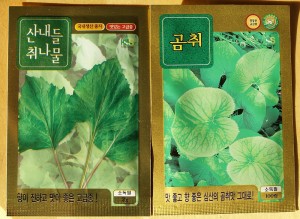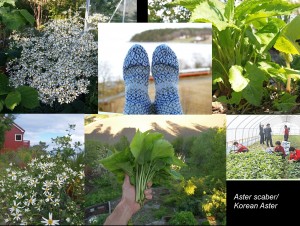Aster scaber was one of the obscure edibles in the Plants for a Future data base http://www.pfaf.org/user/Plant.aspx?LatinName=Aster+scaber
Edible Parts: Leaves; Young plant[105, 177]. No more details are given.
[105]Tanaka. T. Tanaka’s Cyclopaedia of Edible Plants of the World.
[177]Kunkel. G. Plants for Human Consumption.
Ken Fern doesn’t seem to have tried it himself.
There is more information in Cornucopia II (1998):

It wasn’t until February 2004 though that I first came across a source of seed. I had been approached by a guy in Denmark who was very keen to get hold of seed of ashitaba (Angelica keiskei) for medicinal use. He finally found seed on a Korean site http://www.seedkorea.com (now a dead link) and suggested I tried to order and we would share the cost. I wrote “Thanks for the link. Some amusing translations! There are several very interesting edibles on their vegetable list (Aster scaber for example). If I could find out how to order, I would certainly do so and share some Angelica with you. However, I got stuck trying to register. Have you tried? Perhaps we could try and advertise for a Korean speaker to help.”
I finally struck lucky when I noticed this species in Russian botanist Alexandra Berkutenko’s fantastic seed list from the Russian Far East during winter 2006-7 (see http://www.edimentals.com/blog/?p=208).
To give you an idea of the seed she was offering, here is a list of “edibles” I found and ordered at the end of January 2007 together with the Aster:
Actinidia arguta, Actinidia polygama, Allium condensatum, Allium galanthum, Allium hymenorrhizum, Angelica genuflexa, Angelica gmelinii, Asparagus schoberioides, Aster scaber, Cacalia hastate, Caltha natans, Cirsium kamtchaticum, Cirsium pendulum, Claytonia acutifolia, Clintonia udensis, Eleagnus umbellata, Glyccirhiza echinata, Hedysarum arcticum, Princepia sinensis, Ribes dikuscha, Ribes fragrans, Ribes latifolia, Ribes mandschurica, Rubus crataegifolius, Rubus sachalinense, Rubus stellatus
Substitutes: Allium mongolicum, Allium komarovii, Angelica amurensis, Angelica maximoviczii, Angelica sachalinensis, Glyccyrrhiza uralensis
I sowed the seed of Aster scaber in February 2007 and stratified them under a cold frame outside. They germinated promptly outside at the end of April 2007. It subsequently flowered for the first time already in September 2008 and showed me what an amazing edimental this was, with its large umbels of typical white Aster flowers.

It self-seeded the following sping and I was able to make my first harvest in spring 2009, at only 2 years old! It subsequently survived one of the hardest winters we’ve experienced in this area with almost 3 months with hardly a day above freezing, almost no snow cover and the soil frozen solid to the bedrock around the plant’s roots throughout!
Then, in February 2012, I had a surprising phone call from a Korean lady, Misoni Sandvik, in Oslo. My book Around the World in 80 plants takes up the story: “She was a refugee from Korea when she was young and remembered foraging with her grandmother near Seoul. One plant she remembered fondly was Aster scaber. She had recently bought a cottage with a plot of land where she wanted to grow some of the plants she remembered from Korea. She had searched unsuccessfully for some time for seed of this Aster until one day she discovered that this guy up north in Norway had it on his internet seed trade list!”
I of course sent her seed and we continued to chat about her memories of wild edibles in Korea and she also opened up a whole new world of unusual wild edibles other nationalities were using in Norway! This includes another plant in my book, Bunias orientalis or Turkish rocket, adopted by the Thai community in Oslo, the subject of a separate web page where we will meet Misoni again!!
She was so pleased that I sent her seed of this plant so that she could fulfil that dream of experiencing the taste of the plant again that, unknown to me, she had knitted me some socks and here they are as shown in one of my talk slides…the best seed trade I’ve ever made!

Later, we discovered seed of Aster scaber in an on-line Korean vegetable seed list and on the same list I was surprised to find another perennial vegetable that I’d never seen offered before, nor realised was that important, Ligularia fischeri. Thanks to Misoni, I was soon the owner of a couple of packets of both! When I first posted this picture on FB, a Korean friend, Woo Lee, recognising the plants told me that these two plants are used very differently in Korea: 곰취 or Ligularia fischeri is eaten raw, without cooking or steaming. On the other hand, 산내들 취나물 or Aster scaber is steamed or lightly boiled. He also told me that both need a cool shady place with moisture, perfect forest garden plants in other words!
There’s more in my book Around the World in 80 plants!!
More previously unpublished pictures of Aster scaber can be seen by following the link below:


Hi Stephen,
Inspired by your enthusiasm for Aster scaber, I’ve decided to plant it in my own garden. So far, I’ve had no luck tracking it down though, despite trying the usual permaculture nurseries, RHS plant finder (a couple of nurseries have it in their plant lists on the RHS site but not in their current catalogues). In your book, you mention that it’s available from 3 UK nurseries – any idea which ones?
Failing that, have you any idea where else I might find it?
Many thanks!
Joe
Hi Joe!
When I wrote the book there were three nurseries offering the plant, but I guess supply hasn’t met recent demand.
It’s still possible to get seed from Korean vegetable catalogues, but difficult to order seed when you don’t know Korean…maybe you know someone from Korea.
I didn’t get any seed this year and don’t know any nurseries offering it yet…
Contact me in November and I’ll send you seed if I get some this year…
Good luck, Stephen
Great, thanks!
I’d be surprised if I have anything in my garden that you don’t already have, to offer by way of exchange. But do let me know if there’s anything you’re on the lookout for and I’ll keep my ear to the ground…
All the best,
Joe
It’s not necessary…I’m sure you give more than you get back and will pass on Aster scaber to others in due time!!
Many other gardeners have given me plants that I couldn’t pay back…so now it’s my turn :)
Hi Stephen,
just got a bag of seeds from Korea. You say you stratified.
Do you know anything specific about the required temperature range and length of stratification period?
Best wishes, Stefan
No, I’m afraid I don’t. I’ve only germinated outside for a month or more.
You could try asking on my FB group: https://www.facebook.com/groups/273637002647408
have you compared big leaf aster to aster scaber?
I ate it once and mention it in the book. It was a bit too invasive where I had it and I moved it and it will be next spring before I can compare it, but as far as I remember it had a similar taste.